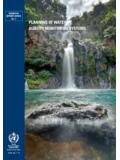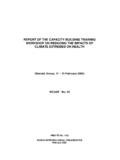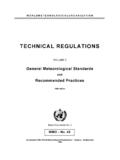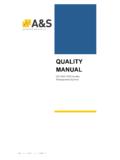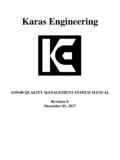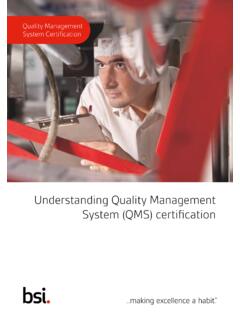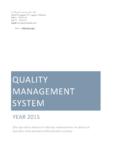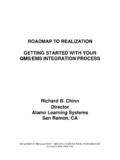Transcription of A PRACTICAL GUIDE FOR THE IMPLEMENTATION OF …
1 W o r l d M e t e o r o l o g i c a l O r g a n i z a t i o n A PRACTICAL GUIDE FOR THE IMPLEMENTATION OF A quality management system FOR national meteorological AND hydrological services QMF WMO/TD No. a 2 A PRACTICAL GUIDE for the IMPLEMENTATION of a quality management system for national meteorological and hydrological services VERSION 10 3 4 Lead Author: Bryan Boase Contributors: Helen Tseros Geoff Gray Neal Moodie Editorial.
2 C M Shun Herbert Puempel 5 6 DOCUMENT CONTROL Version No. Date Comments V1 28 Aug 2011 First Draft V2 3 Sept 2011 Amendments post first draft proof read V3 8 Sept 2011 Expansion of Sections 4 & 5 V4 8 Sept 2011 Amendments post proof read of V3 V5 9 Sept 2011 Amendments post proof read of V4 V6 19 Sept 2011 Editorial proof read amendments H Puempel V7 4 Oct 2011 Addition of timeline figure 5 page 54 V8 2 Dec 2011 Amendments from Hong Kong Observatory and President of CAeM V9 14 Dec 2011 Final editorial corrections in preparation for translation V10 20 Dec 2011 Correction to Figure labelling 7
3 8 Contents Foreword to the 11 Purpose of the 13 Terminology, vocabulary, abbreviations and 15 SECTION 1: 17 A brief history of quality 17 The primary drivers for adopting a QM approach for 17 SECTION 2: quality management and 21 The International Organization for Standardization (ISO).. 21 The ISO 9000 family of 21 The importance of the ISO family of 22 Corporate Governance and ISO ISO 9001 certification and 23 What ISO 9001 certification does not 24 Benefits of ISO 9001 25 ISO Standards and 26 SECTION 3: The Eight Principles of quality 29 29 The Eight 29 SECTION 4: The Structure of ISO 31 31 The ISO 9001 31 Explanatory notes on the 32 SECTION 5.
4 Steps for implementing a quality management 55 IMPLEMENTATION 55 Step 1 - Gain the formal endorsement of top 57 Step 2 - Selecting the NMHS quality 57 Step 3 - Enlist the assistance of an experienced organization or 58 Step 4- Providing introductory ISO 9001 training for 58 Step 5 - Conducting a gap 58 Step 6 - Identifying processes and developing 59 Step 7 - Establish appropriate customer satisfaction measures and tools to acquire this 59 Step 8 - Identify and train appropriate staff to undertake the role of an internal 60 Step 9 - Conducting internal 62 Step 10 - quality management Review 63 Step 11 - Selecting an organization to perform the ISO compliance 63 Step 12 - Preparing for an external 64 SECTION 6: 65 A: Generic Product/Activity Development Planning 67 B.
5 Generic Product Acceptance 71 C: Example of a Customer Satisfaction 73 D: Example of a generic non-conformance 77 E: Sample job description - quality 79 F: Enlisting the assistance of an experienced organization or 81 9 G: Part A: Gap 83 H: Part B: Gap Analysis 107 I: Generic web feedback 112 J: Generic quality management Review Meeting 116 K: Internal Audit 118 L: Internal Audit Check 120 M: Internal Audit 122 N: quality management Internal Audit 124 10 The Foreword to be provided by the WMO Secretary-General provided along the lines of: Foreword to the GUIDE The concept of quality is not new to WMO or its Members.
6 In some cases for over 100 years we have and will continue to strive to deliver the highest quality products and services . In today s world the users of meteorological and related data, products and services are increasingly requesting that quality management systems be in place to help provide a level of assurance on the quality of that data, products and services . As a result of this increasing demand, the WMO Congress has adopted Resolution 27 (Cg-XIV) and decided that WMO will work toward a quality management Framework (QMF) for national meteorological or Hydrometeorological services .
7 I highly recommend this GUIDE to all WMO Members who have, or are about to adopt a quality management approach to the delivery of their services . 11 12 Purpose of the GUIDE The purpose of this document is to provide the guidance required to develop and implement a quality management system (QMS) to ensure and enhance the quality of NMHS products and services . As well as developing and implementing a QMS, it also details the steps that need to be taken to achieve certification of compliance of your organization s QMS, with the International Organization for Standardization (ISO) Standard, ISO 9001:2008 quality management system Requirements (ISO 9001).
8 The GUIDE is based on the significant PRACTICAL experience gained during the development and IMPLEMENTATION of QMSs from a variety of organizations. Combined with this is the collective wisdom of the resource material available from NMHSs with mature QMSs and organizations such as the International Organization for Standardization (ISO). The GUIDE will be provided in a hard copy version but the prime publishing format will be on-line as a foundation resource document on the WMO-QMF web site (hyperlink when URL known).
9 Wherever possible, resources will be hyperlinked into the document to ensure as much as possible, the longevity of the document in terms of its currency and ongoing value. The GUIDE is primarily a web-based living document and in line with the QM philosophy of continuous improvement, it will be reviewed, amended and updated on a regular and ad hoc basis. As such, input from our NMHS QM practitioners will always be welcomed and included on a consensus basis. 13 14 Terminology, vocabulary, abbreviations and definitions The QMS technical terminology, vocabulary and definitions used throughout this document are those of the International Organization for Standardization (ISO) and in particular, those identified in ISO 9000:2005 quality management systems - Fundamentals and Vocabulary.
10 The meteorological and aviation terminology, vocabulary, abbreviations and definitions used throughout this document are those of the World meteorological Organization (WMO), International Civil Aviation Organization (ICAO) and other organizations as appropriate. As a starting point, there is merit in defining from WMO s perspective the difference between a GUIDE , a manual and a technical regulation and provide some examples that the reader will be familiar with: GUIDE : a publication provided by an agency that contains a set of instructions to assist in interpreting and applying a regulatory requirement.
